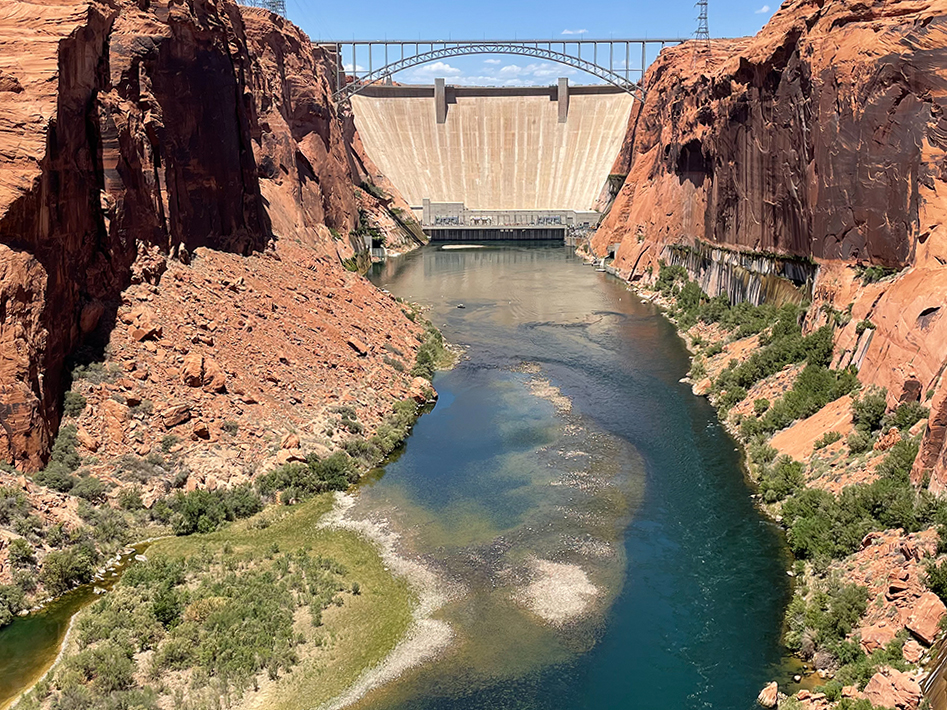Purpose is to identify and analyze operational alternatives at the dam for disrupting invasive fish from spawning and to consider altering the High-Flow Experiment process
 Glen Canyon Dam in Page, Arizona.
Glen Canyon Dam in Page, Arizona.
PAGE, Ariz. – The Bureau of Reclamation today announced it is initiating the formal process to develop future alternative operations at Glen Canyon Dam aimed at disrupting invasive fish from spawning downstream. The proposed flow options would potentially run through 2027.
Reclamation undertook an environmental assessment in August 2022, entitled Glen Canyon Dam/Smallmouth Bass Flow Options, which was released for public comment Feb. 24. Based on the environmental assessment analysis and nearly 7,000 comments received, Reclamation concluded that additional analysis was warranted.
On June 6, the Glen Canyon Dam Adaptive Management Work Group directed Reclamation to prepare a supplemental environmental impact statement to the December 2016 Glen Canyon Dam Long Term Experimental and Management Plan Record of Decision.
As the water elevation at Lake Powell has declined, the epilimnion, or upper layer of the lake where most fish reside, has become closer to the water intakes for Glen Canyon Dam, meaning that nonnative fish are now more likely to pass through the dam and downstream into the Colorado River. The epilimnion is also the warmest, top-most layer of the reservoir and, when discharged downstream, increases the temperature of the river. These warmwater releases are creating ideal spawning conditions specifically for smallmouth bass, a predatory invasive fish species which poses a threat to the federally protected humpback chub and other native fish.
“We will continue our work to protect the river and its native species to the best of our ability as we plan our operations of the river,” said Reclamation Commissioner Camille Calimlim Touton. “If smallmouth bass continue to spawn and establish below Glen Canyon Dam, there will likely be negative impacts to the humpback chub and other native fish species.”
“Reclamation has obligations under the 2016 Long-Term Experimental and Management Plan Biological Opinion to protect humpback chub,” said Reclamation Upper Colorado Basin Regional Director Wayne Pullan. “Humpback chub were recently downlisted from endangered to threatened. However, in the Grand Canyon, the number of sub-adults has been low enough to trigger taking additional conservation actions to bolster the population by increasing survival and growth.”
It is estimated there are approximately 60,000 humpback chubs below Glen Canyon Dam, with some residing in and around the Little Colorado River’s confluence with the Colorado River approximately 75 miles downstream of the dam, and a larger population in the Western Grand Canyon beginning approximately 175 miles downstream of the dam.
For the scoping process, Reclamation will analyze a range of reservoir releases with temperature and flow velocity combinations. This will include a flow option that does not use the dam’s river outlet works to reduce water temperatures. These analyses will help determine the ability to disrupt smallmouth bass spawning behavior to prevent their establishment below the dam. Reclamation will also update the high flow protocol sediment accounting process to incorporate the latest scientific information.
The Notice of Intent to prepare a Supplemental Environmental Impact Statement and a modified Record of Decision for the 2016 Long Term Experimental and Management Plan requests that the public submit comments concerning the scope of specific operational guidelines, strategies, and any other issues that should be considered, as well as to consider potential impacts on the resources below Glen Canyon Dam, including natural and cultural resources, endangered species, recreation, water, hydropower, and other resources and uses. Reclamation will host two public webinars to provide summary information and receive oral comments. The Notice of Intent will be available for public comment for 30 days after it is published in the Federal Register.
For more information, visit https://www.usbr.gov/uc/progact/amp/index.html.


